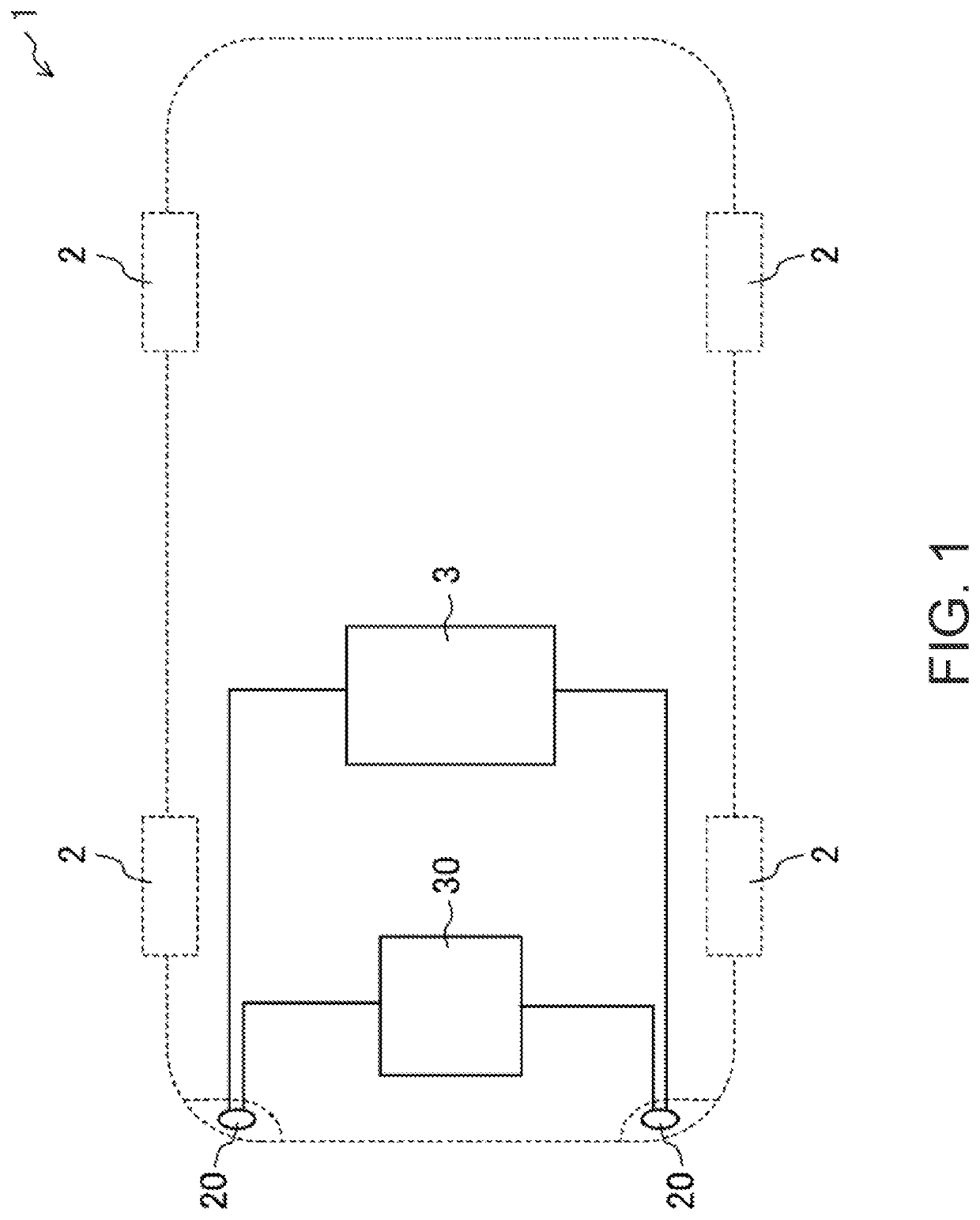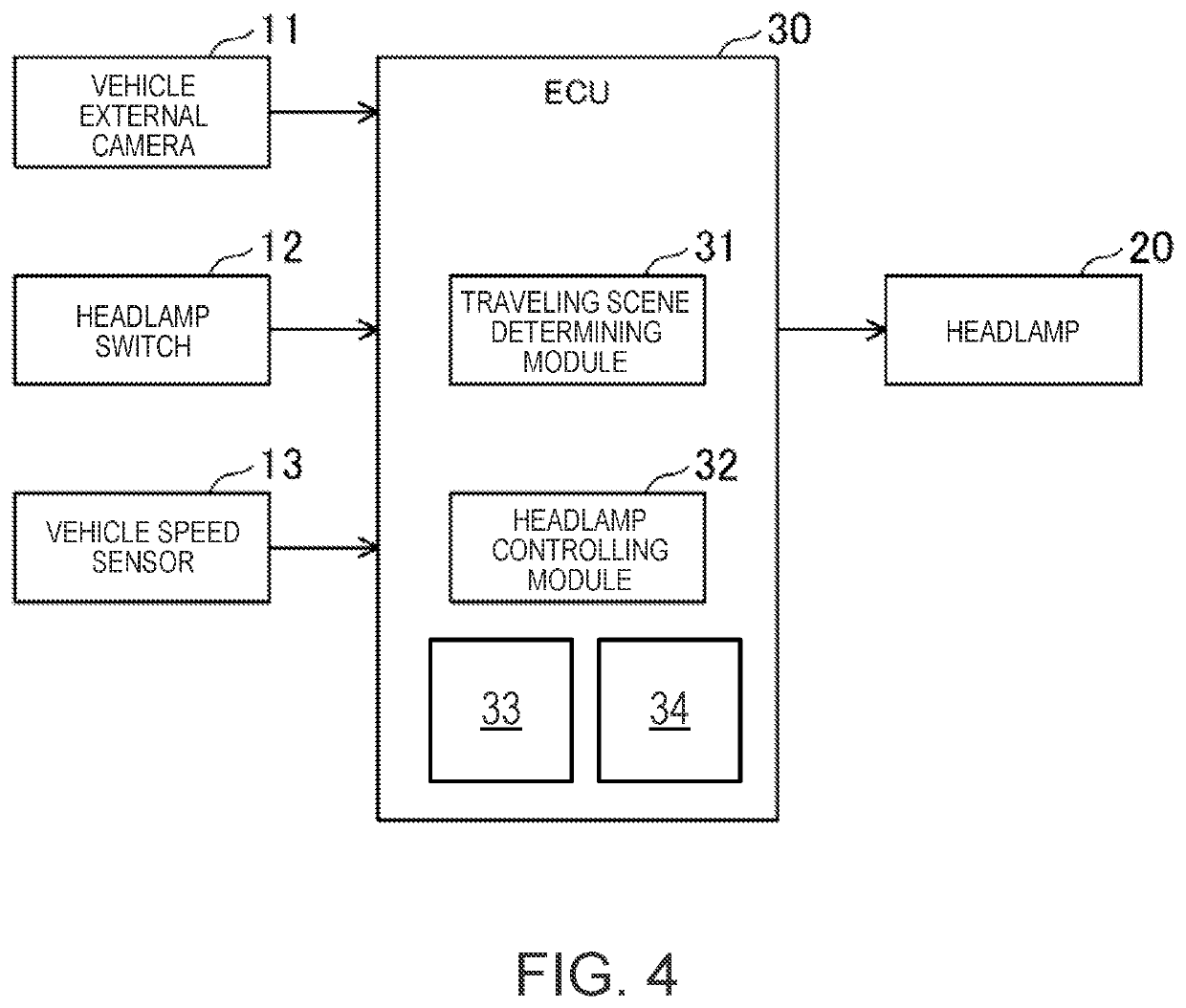Headlamp control device
a control device and headlamp technology, applied in semiconductor devices, light sources, transportation and packaging, etc., can solve the problems of driver's pupils contracting and becoming smaller, the driver's ability to visually recognize the road state, and the road state deteriorating
- Summary
- Abstract
- Description
- Claims
- Application Information
AI Technical Summary
Benefits of technology
Problems solved by technology
Method used
Image
Examples
embodiment 1
[0031]FIG. 1 illustrates a vehicle 1 having a pair of headlamps 20 controlled by a control device according to Embodiment 1 (a body-system ECU 30 described later). The vehicle 1 is a four-wheel automobile in which two wheels (here, front wheels) among four wheels 2 located symmetrically in the left-and-right direction are driven by a drive unit (not illustrated). Therefore, the vehicle 1 moves (travels). In the following description, front, rear, left, right, up, and down of the vehicle 1 are simply referred to as front, rear, left, right, up, and down, respectively.
[0032]The pair of headlamps 20 are provided at the left and the right in a front part of the vehicle 1, and illuminate the road ahead of the vehicle 1. Although detailed illustration is omitted, each headlamp 20 is disposed so as to continue to a front fender of the vehicle 1. The headlamp 20 is electrically connected with a battery 3. The headlamp 20 is turned on when electric power is supplied from the battery 3.
[0033]...
embodiment 2
[0063]Hereinafter, Embodiment 2 is described in detail with reference to the accompanying drawings. Note that in the following description, the same reference characters are assigned to common parts to Embodiment 1 to omit the detailed description.
[0064]As illustrated in FIG. 9, Embodiment 2 differs from Embodiment 1 in that a detected result of a steering torque sensor 14 is inputted into the ECU 30. Moreover, Embodiment 2 differs from Embodiment 1 in a condition for the headlamp controlling module 32 executing the brightness adjusting control. In detail, the headlamp controlling module 32 does not execute the brightness adjusting control, when the traveling scene determining module 31 determines that the vehicle 1 is turning to the right or to the left at an intersection. When the vehicle 1 turns to the right or turns to the left at the intersection, the driver needs to carefully watch the road state near the vehicle rather than the road state distant from the vehicle. If the brig...
embodiment 3
[0076]Below, Embodiment 3 is described in detail with reference to the accompanying drawings. Note that in the following description, the same reference characters are assigned to common parts to Embodiments 1 and 2 to omit the detailed description.
[0077]Embodiment 3 differs from Embodiments 1 and 2 in a condition for the headlamp controlling module 32 executing the brightness adjusting control. In detail, when the traveling scene determining module 31 determines that an amount of environment light around the vehicle being more than a given amount, the headlamp controlling module 32 does not execute the brightness adjusting control. This is because, if there is much environment light around the vehicle, the driver's visual recognition ability hardly improves by the brightness adjusting control. That is, even if the brightness adjusting control is executed, the driver is hardly able to recognize the brightness gradient of the light of the headlamp 20, since the effect of the environm...
PUM
 Login to View More
Login to View More Abstract
Description
Claims
Application Information
 Login to View More
Login to View More - R&D
- Intellectual Property
- Life Sciences
- Materials
- Tech Scout
- Unparalleled Data Quality
- Higher Quality Content
- 60% Fewer Hallucinations
Browse by: Latest US Patents, China's latest patents, Technical Efficacy Thesaurus, Application Domain, Technology Topic, Popular Technical Reports.
© 2025 PatSnap. All rights reserved.Legal|Privacy policy|Modern Slavery Act Transparency Statement|Sitemap|About US| Contact US: help@patsnap.com



